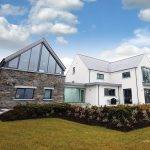Heat treated wood is softwood that has been subject to high temperatures, changing the cell structure by a chemical free process, creating a darker wood. It makes the timber more stable and durable although the strength properties are reduced. The main benefit lies in improved weather resistance and greater immunity to fungal attack, thus the wood is less inclined to rot. A reduction in moisture content is also achieved. Heat treated wood is used for fencing, cladding, decking, windows, doors and garden furniture.
Tension free timber In conventionally dried timber, the moisture content in the middle may be higher than at the outer edge, but over time this evens out. However, as timber shrinks when it dries, this difference in moisture content can result in defects such as splits. Steaming or ‘stress relief schedules’ are used to stabilise the timber and reduce differences in moisture content. Stress relief schedules typically include a short period of high temperature and humidity near the end of the kiln drying process to allow the surface layers to “expand” or “relax” to reduce internal stresses caused by rapid drying. Tension free timber has greater stability, fewer defects and is thus particularly suitable for joinery products and mouldings.
Veneers are characterised by the natural features of the wood, and also from where and how it was cut. For example, Burr or Burl veneer are abnormal growths on tree trunks, Butt veneers are cut from stumps. Cutting methods are broadly of three types: saw cutting, rotary cutting and flat slicing. Construction veneer has a thickness of between 1.5mm to 6mm, decorative sliced veneer about 0.6mm.
Plywood is made from thin sheets of wood laminated (glued) together forming a strong and stable board. It can be made from both softwoods and hardwoods. It is graded from A-D with A grade being the best because it is very smoothly faced and virtually free from defects whilst D grade can have the maximum permitted amount of knots, holes, splits etc. Decorative plywood has a veneer on its outer layer of the selected wood species such as walnut or maple. Spruce is commonly used by the builder for wall, floor and roof construction. Birch is useful for non-structural purposes such as wall and floor finishes, furniture and formwork. They have an individual grading system. Spruce is graded 11/111 (i.e. both sides) or 111/111. An 11 grading means fewer knots and defects on that side. Birch is graded from B (clean face, few blemishes, suitable for internal use and clear finishing) to WG (many face defects, suitable for carcase and packaging use). Most of this structural plywood is sourced from Finland, Sweden, America and Canada, the Nordic plywood from Finland is the one used predominately in the UK and Ireland. The current plywood standard is EN 636, in three parts covering interior, moist, and exterior applications. I.S. 444 / BS 5268 give stresses for structural applications. Specialist tropical plywood veneers include marine ply which has very good weather resistance and strength. Plywood for general interior use often originates in the Far East. It’s important to note that there are serious concerns over the sustainability of tropical plywoods imported into Europe, so make sure to check for accreditation such as FSC when buying.
Blockboard is classed as a plywood because it is a laminated construction, the difference is what comes as the ‘filling’ of the ‘sandwich’: the core is of solid strips rather than veneer or thin sheets. These strips may or may not be glued together (often edge butted).
[adrotate banner="58"]Particle boards are usually made from small chips of softwood bonded with a resin under hot, high, pressure. They are very useful as the base for a veneer be it wood or plastic. Chipboard is the most common but standard chipboard must be kept dry otherwise it will swell permanently out of shape. There are special chipboards for use in wet areas. Oriented Strand Board (OSB) is a member of this family. It consists of long strands of softwood arranged in layers, with each layer running in an opposite direction giving these boards much of the strength properties of plywood. When manufactured as a ‘sandwich’ with an internal layer of insulation (usually extruded or expanded polystyrene) it becomes a SIP or structural insulated panel. These are rapidly becoming a popular way to build because they are produced under factory conditions, have excellent thermal qualities and are quick to erect on site. OSB is manufactured in Ireland (Waterford).
Flakeboard is very similar to OSB but because it is made from flakes and not strands glued at right angles to each other, is not as strong.

